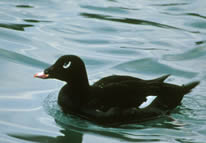Wildlife - Species

Species Specific Regulations
White-Winged Scoter
Licenses: Hunting License required. Migratory Bird Hunting and Conservation Stamp (Federal Duck Stamp) that is validated by the hunter signing the stamp in ink across the face of the stamp
Limits: Please see Migratory Bird Regulations for any game zones restrictions or Limitations.
White-Winged Scoter (Melanitta deglandi )

Description
White-winged scoters are among the heaviest and largest of all ducks. They can be differentiated from the other scoters by their large white speculum on their black wing.
Average Size
White-winged scoters have an average length of 21 1/2 inches and an average weight of 3 1/2 pounds.
Range
The white-winged scoter can be found in all 4 flyways but is most common in the coastal flyways. The white-winged scoter is found in South Carolina in the winter months along the coast.
Preferred Habitat
During the summer months white-winged scoters can be found in large freshwater or brackish lakes and permanent ponds. In the winter months they frequent coastal estuaries, bays, and open coastline with shallow water.
Food Habits
The diet of the white-winged scoter is made up of aquatic and marine mollusks, crustaceans, and insects. They will also occasionally consume aquatic plants and fish.
Reproduction
Breeding pairs likely form during spring migration. The nest is build away from water, and hidden in dense cover. They will frequently use old nest structures and have been known to take over nests of other species. Nest structures are created from a depression in the ground, lined with down, grass, and twigs. The female then lays 6-16 creamy buff eggs in the nest.
Sound
Drakes utter a whistling note during display. Not very vocal.
Behavior
- One of the latest migrating and nesting waterfowl.
- Male defends moving area around female during breeding season.
- Often form large flocks outside the breeding season.
Citations, Publications and Literature
U.S. Fish & Wildlife Service, Federal Duck Stamp Office Presents: North American Waterfowl (Adobe PDF file)
Brown, Patrick W. and Leigh H. Fredrickson. 1997. White-winged Scoter (Melanitta fusca), The Birds of North America Online (A. Poole, Ed.). Ithaca: Cornell Lab of Ornithology; Retrieved from the Birds of North America Online
South Carolina waterfowl hunters 16 and older are required by state law to obtain a state migratory waterfowl permit and Migratory Game Bird permit. Both permits must be in the hunter's possession while hunting or transporting legal waterfowl. A state waterfowl permit is included with the Lifetime Senior, Lifetime Gratis and Disability Licenses. S.C. residents who hold a Lifetime Senior or Lifetime Gratis License are not required to have a Migratory Game Bird permit.
National Migratory Bird Harvest Information Program (HIP)
The waterfowl permits and HIP permits are available from select DNR offices and from hunting and fishing license agents.
